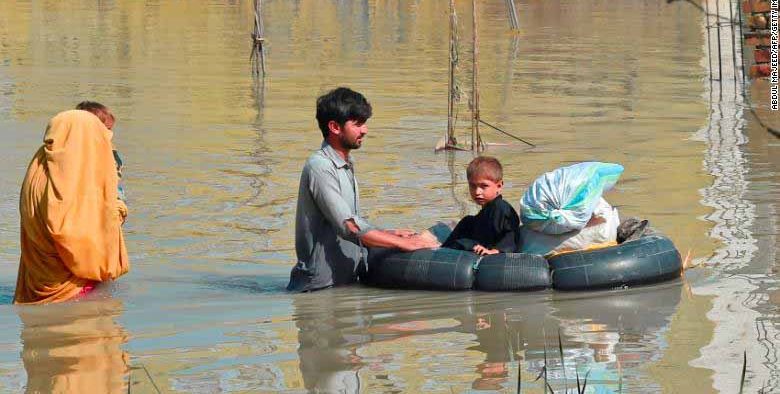Rising flood risk due to spring rains: NDMA

Three provinces in the nation are at higher danger of flooding as a result of the country’s continuous spring rains, which prompted the National Disaster Management Authority (NDMA) to advise concerned authorities to exercise caution.
The NDMA spokesman said in a statement released on Friday that Pakistan may continue to experience sporadic showers till April 22.
Flooding is anticipated in the Balochistani districts of Kech, Kalat, Khuzdar, and Awaran as a result of recent rainfall. Up to April 21, there is a chance of flooding in Khyber Pakhtunkhwa (K-P)’s Malakand, Swabi, Kohistan, Mardan, Shangla, Charsadda, Swat, and Nowshera.
Punjab’s districts of Rajanpur and Dera Ghazi Khan are also expected to experience flooding. From April 25 to 29, more rain and hailstorms are predicted in a few locations of Balochistan, K-P, Gilgit-Baltistan, and Azad Kashmir.
The Provincial Disaster Management Authorities (PDMAs), along with other administrative agencies and district administrations, have all been directed to stay vigilant in case of an emergency.
Thus far, 36 people have died as a result of the intense rains that have affected several K-P regions. A PDMA report states that eight men, eight women, and twenty children are among the deceased.
Additionally, 46 individuals have been injured in rain-related incidents. Eleven children, 33 adults, and nine women are among the injured.
Rains have caused damage to 2,003 residences in different K-P districts, causing roofs and walls to fall. The PDMA reports that 388 dwellings have been totally destroyed.
Khyber, Upper and Lower Dir, Chitral Upper and Lower, Swat, Bajaur, Shangla, Mansehra, Mohmand, Malakand, Kurram, Tank, Mardan, Peshawar, Charsadda, Nowshera, Buner, Hangu, Battagram, Bannu, North and South Waziristan, Kohat, DI Khan, and Kozai have all suffered losses in life and property as a result of the recent heavy rains.
The PDMA has allocated Rs110 million to the impacted district administrations for relief efforts and financial support to the relatives of the deceased, per the special instruction of the chief minister of K-P.
The impacted districts of Swat, Chitral Lower, Bajaur, Kohistan Lower, Peshawar, Nowshera, Mohmand, Upper Dir, Tank, and DI Khan have received relief supplies from the PDMA. In the impacted regions, relief efforts are still underway. Relief supplies include tents, mats, kitchen sets, blankets, mattresses, tarps, solar lights, and other everyday necessities.
In the last three days, 16 people have died in Balochistan due to torrential rainfall. Six men, five women, and five children are among the dead, with the Chaman district accounting for the majority of the deaths.
The Chaman region was most hit, with eight confirmed deaths and significant property damage. Over 100 residences had some damage, but sixty were totally demolished. Twelve roads and two bridges were also swept away, which exacerbated the situation and caused traffic disruptions. The situation worsened in the Makran belt and Gwadar, when flash floods flooded large regions, submerging them.
The PDMA reports that rescue operations are under progress in the impacted regions and that 55 people have been successfully removed from the affected locations. The province administration has declared a state of emergency in response to the catastrophic situation in order to enable prompt and coordinated action.
According to an official statement, authorities are concentrating on long-term steps to lessen the effect of future catastrophes while simultaneously organizing resources to offer relief and support to individuals impacted.
Beginning on April 23, a fresh round of rain is predicted for Punjab, with the top portions of the province seeing mostly light rain.
In upper Punjab, thunderstorms with significant rainfall and hailstorms are predicted for April 26–29, according to a bulletin released by the PDMA.
“Punjab has already received a rainfall notice for the period of April 18–21. Before harvesting wheat crops, farmers are encouraged to examine the weather,” the statement stated. It went on to say that the following 10 days are critical for district administrations and rescue services.
It stated that the administration is always on guard, following the chief minister of Punjab’s orders.
“All district provincial administrations have been notified of the recent weather. The PDMA is keeping a careful eye on the weather. It said that efforts will be made to reduce the harm caused by rains and natural calamities.
The NDMA stated in a statement that it has counseled the appropriate authorities to monitor the weather and make the required preparations, particularly with regard to harvesting wheat.
“We advise visitors and travelers to stay away from needless trips to hilly regions. If they must travel, they should keep themselves updated on the routes and weather.
Don’t cross streams that are nourished by rain. Avoid standing near electrical poles, makeshift buildings, and damaged roofs or walls. People who live in hilly regions need to be aware of the possibility of landslides.
“Avoid riding in open-roof automobiles, motorcycles, or bicycles while lightning is present. It also said, “Avoid high-rise structures, trees, poles, mountains, antennae, moving towers, etc.

I am a dedicated student currently in my seventh semester, pursuing a degree in International Relations. Alongside my academic pursuits, I am actively engaged in the professional field as a content writer at the Rangeinn website.








